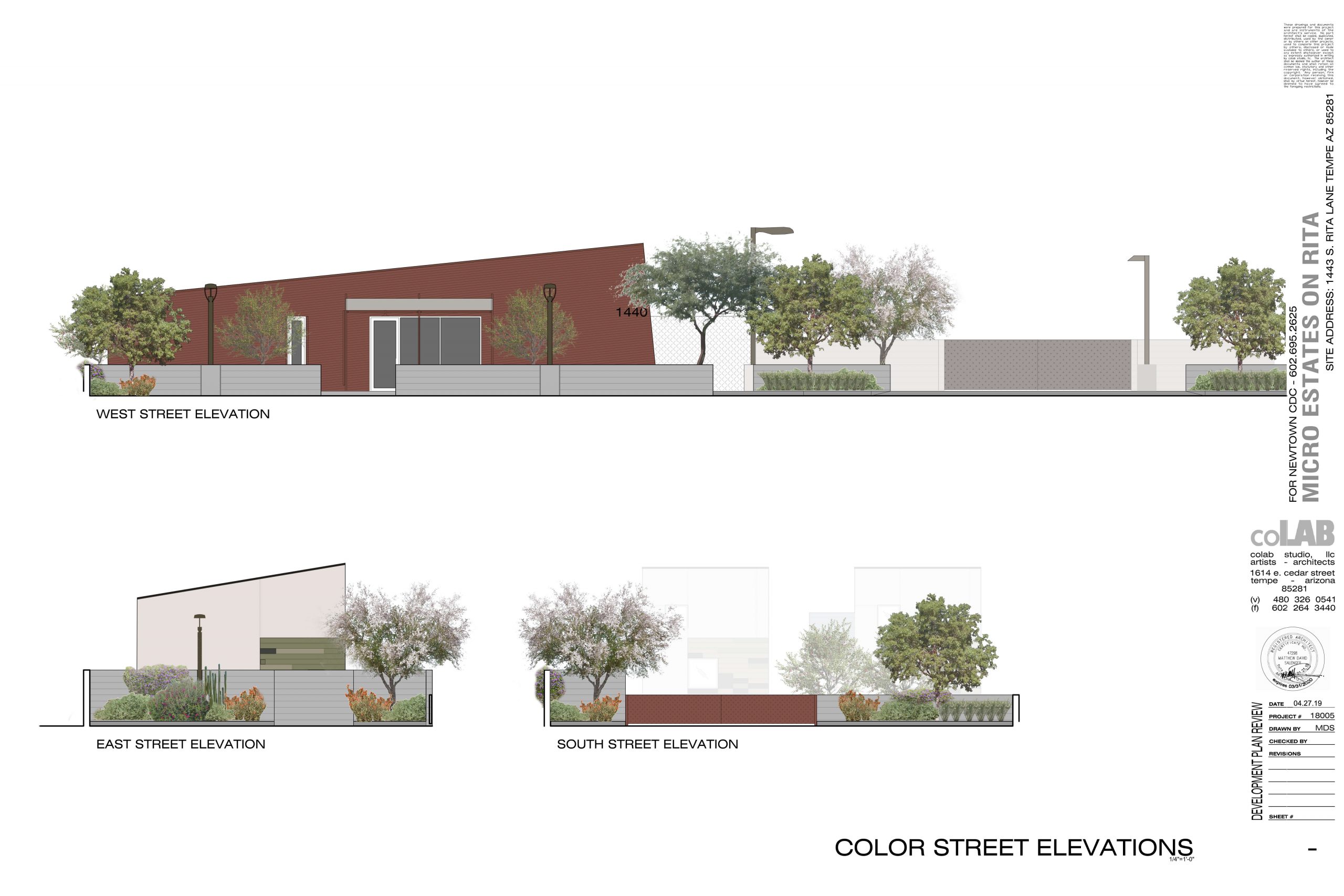Small living makes a huge impact
By Barbi Walsh
Tempe Micro Estates is a scaled-down version of a master-planned community with a huge impact. Made up of 13 small homes—or humble homes, as they are often referred to—the LEED-certified development is leading the way into sustainable housing and communities. Built with high-quality, sustainable materials, these stand-alone units take tiny home living to another level. Modern architecture pairs with environmentally friendly appliances and materials, making the 600-square-foot loft-style, one-bedroom home feel upscale and spacious. A small private yard is also included, giving homeowners even more space to relax and enjoy.
Each residence faces a central courtyard with desert-friendly Sonoran landscaping. Orchard and shade trees, as well as native and edible plants, create a serene and inviting park-like space where neighbors can enjoy the beauty of the outdoors. There’s even a kitchen garden area where residents can grow their own fresh and healthy foods, says Kirsten Shaw, chief sustainability officer (CSO) of Sustainability Advisors Corporation and collaborator of the project.
“Tempe Micro Estates is designed as an ‘intentional neighborhood,’” she says. “It creates a courtyard community where neighbors want to connect with one another while reducing the impact on the environment.”
Anchored by a 900-square-foot Common Room, The Estates provides a place to residents where they can gather, share meals, relax, and interact with neighbors and friends. “Even though each home is small and private, the sense of community around it is big,” Shaw says.
Green Think Tank; Sharing Ideas
Those behind the passion and innovation in developing Tempe Micro Estates include non-profit Newtown Community Development Corporation and ASU SkySong, who, along with ASU interns,conceived and collaborated on the project.
Located on a small plot of land in downtown Tempe, The Estates will be built on just under an acre of public-owned land designed with an eye on the future. The homes feature everything eco-friendly, such as using gray water to irrigate, and ductless ventilation to keep dust out. These homes have it all.
The many organizations involved haven’t missed a thing, and have helped make the model for Tempe Micro Estates replicable. The hope is to inspire builders to take on the concept of sustainable building and creating sustainable neighborhoods, says Heather Szymanski, building and community advisor for Sustainability Advisors Corp. But finding the information, resources or funding isn’t always easy. It can be daunting to find out even where to start the process, Shaw says. Having the replicable project gives builders a starting point for achieving sustainable goals.
ASU SkySong is like a think tank where industry leaders, students and faculty can translate collaborative thoughts and experience into business and actions. “The replication process helps people plug and play, we’re gap fillers,” Szymanski says. “We have builders, engineers, investors, developers, realtors, marketing people and students all working together to create an amazing project that is good for the environment, economy, and for the community,” she adds.
Sharing the Wealth
It’s not just the environment that benefits from this innovative project. Homeowners of all incomes are able to purchase one of these new modern homes. One of the ideas behind Tempe Micro Estate is to make it possible for many who have been squeezed out of the housing market to afford the best in eco-living. Prices are affordable and designed to make homeownership accessible to first-time homeowners or hard-to-qualify home purchasers, says Shaw.
According to Newtown’s website, over half of the homes will be sold below market value, giving opportunities to those who might be priced out of homeownership. HUD affordable housing financing is available for those who qualify. To qualify, prospective buyers must have a household income lower than 80 percent of the area’s median income.
Shaw says that homebuyers who are single, or empty nesters, sometimes do not qualify for special housing or for conventional loans and are left out of homeownership; others just do not want the average 2,000-square-foot home. Fortunately, Tempe Micro Estates fits both needs.
The homes are zoned as single-family, which also allows for traditional financing. As the trend for smaller, more environmentally friendly housing heats up, everyone in the housing industry can benefit from the replicable process that Tempe Micro Estates has set in motion.
Building Green For the Long Haul
Housing costs continue to rise; however, incomes are not keeping up, Shaw says. Add the increasing demand on the planet for resources, and building with the future in mind is paramount. According to Shaw, most homes are built to last only 50 years, which means tearing down and rebuilding. Shaw adds that almost 70% of the electrical consumption and close to 40% of all energy used comes from the U.S. building industry.
“We need to build homes to last to use less energy; we need to build them in ways that meet our needs today without compromising the needs of our children and grandchildren and the future,” Shaw says. Builders in the Valley want to keep up the trend for smaller, greener and walkable communities, agrees realtor Nancy Parana.
“Builders are moving with the trends.” Savvy, educated buyers, like millennials, want a different type of home; concern for the environment and less maintenance and expense are driving their home purchases. “Millennials are experience-driven. They don’t want the 7,000-square-foot home,” Parana says.
The demise of the McMansion isn’t new. The decline and disinterest in the huge style home started to shift back in 2017, according to a report in Business Insider by Madeline Stone. She points out that the shift away from conspicuous consumption is part of the post-recession attitude. Parana sees this more now than ever in buyers. “They’re well-educated and want to spend their money on experiences, not spend money on maintenance of the mega-mansions,” she says. And, walkable neighborhoods top of their list of priorities, she says.
Tempe Micro Estates fills those shoes easily. It’s conveniently located near light rail and the future Tempe Streetcar, and is close to employment, shopping, healthcare and entertainment in the downtown Tempe area.
Healthy Minds and Hearts Start with Healthy Neighborhoods
Building sustainable communities is as important as sustainable building practices. Creating a closer-knit neighborhood isn’t just about meeting the needs of savvy, progressive, edgy-green home buyers, it’s for everybody, mind and soul. Communities connect people, and connecting with others combats loneliness. The feeling of isolation is a huge problem in our current society.
Everyone from the youngest generation to those living on the “fringe” of society and to the elderly suffers from some form of loneliness in our tech-driven world. Having opportunities to connect on a more physical and personal level helps stave off the negative effects of isolation. Feeling lonely today is nearly as prolific as smoking was decades ago. No one thought much of smoking, but years later we’re seeing the detrimental effects it has on health.
Loneliness is Today’s Pack-a-Day.
The feeling of loneliness can be just as lethal as smoking about 14 cigarettes, researchers reported on www.psychologytoday.com The findings go on to report that the death rate for people who feel lonely is 50% higher than those with healthy relationships. Numerous studies have also linked loneliness to suicide, substance abuse and increased risk of poor health outcomes, including Alzheimer’s and other related dementias, according to the Journals of Gerontology. Social connectedness is vital to communities and people, and as Szymanski says, we’re broken in terms of community.
“We’ve lost our sense of community,” she says. “The sense of community is bringing people together.” It turns out that coming together with people from your community, whether planning events or engaging in shared activities, such as gardening, help people feel part of something, part of a group, which can lessen the anxiety often felt in our disengaged society, studies show. “In considering the development of a neighborhood, there need to be ways for the people living there to reasonably get to work, shopping and other venues that add to the quality of life in our culture. Also, having places to grow food right outside their doors makes the community more resilient,” Shaw says.
And just maybe this little neighborhood and housing project might be the next big thing in creating a sustainable community by creating affordable, sustainable homes for the future of all of us.
For more information, visit www.newtowncdc.org.
Keep up with all of Green Living’s content by visiting our website.
Barbi Walsh is a freelance journalist and veteran flight attendant with a serious case of wanderlust. When she’s not globetrotting her family around the world, she can be found geeking out over food, fitness and fashion at home.









What is the “affordable” HOA for this community and what does it cover? Many people are being pushed out of their homes due to the high cost/ rising cost of the HOA. Now these HOAs have created “pass-through” laws (should be illegal), but they allow the HOA to just pass the cost of what used to be covered by the HOA to the homeowners. So not only do you get to pay a ridiculous $200+ for the HOA but now they can pass whatever repair cost back to the homeowners. If we are truly concerned with helping people with sustainable affordable living, we need better protection against the egregious HOAs and their abuse of power. My HOA has CC&RS that state “an increase of HOA FEES CANNOT BE ANY MORE THAN 5% FROM THE LAST YEARS INCREASE”…However they increased it by $10.00 in 2020 then another 21% more in 2021. But there is nobody to enforce the CC&RS that we all agreed to.
I do like the idea of a community coming together and selling to someone who truly wants to live in the home they purchased and not allowing big corporate home buyers to pay cash to rent them all out for a ridiculous price. We also need to stop the large groups or wealthy foreigners from collecting properties to then rent out a outrageous prices…But I digress.
I would like to know,(for a friend), how much the monthly fees are.
Thank you.